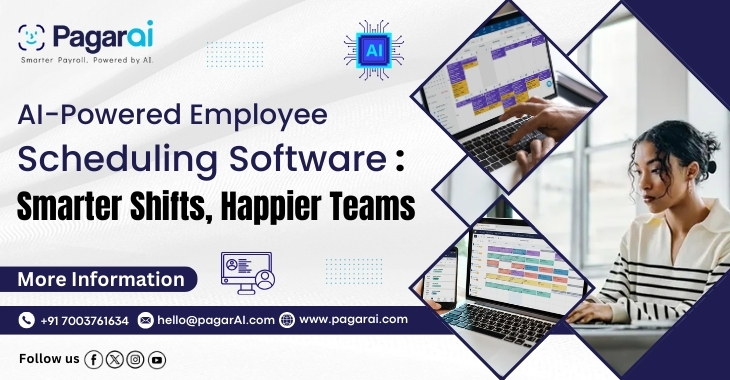Employee scheduling isn’t just about filling time slots — it’s about aligning the right people, with the right skills, at the right time.
A poorly planned schedule can lead to burnout, absenteeism, and low productivity. On the other hand, AI-powered employee scheduling software can turn workforce planning into a data-driven advantage.
By integrating with AI workforce management systems, face recognition attendance systems, and AI productivity tracking tools, businesses can automate schedules, ensure fairness, and adapt instantly to changes.
1. What is AI-Powered Employee Scheduling Software?
This software uses machine learning and predictive analytics to create optimal schedules based on:
- Staff availability & preferences
- Historical demand patterns
- Skill sets and certifications
- Compliance and labor laws
Unlike manual scheduling, AI adapts in real time, making it a dynamic workforce tool.
2. Core Features That Make AI Scheduling Different
Demand Forecasting
AI predicts peak hours, seasonal trends, and special events, allowing businesses to staff appropriately.
Example:
A retail chain uses AI to increase staff before a holiday sale while reducing overstaffing on slow days.
Integration with Attendance Tracking
Linking schedules with face attendance machines ensures:
- Employees clock in/out according to their assigned shifts
- No-shows and late arrivals are flagged instantly
- Overtime is tracked automatically
Productivity-Based Scheduling
AI evaluates past productivity data from employee monitoring software to assign shifts to employees who work most efficiently at specific times.
Automated Shift Swapping
Employees can request swaps directly in the system without long email chains, ensuring fairness and transparency.
3. Benefits of AI-Powered Scheduling
Improved Accuracy
No human error in availability tracking or overtime calculation.
Higher Employee Satisfaction
Fair shifts reduce turnover and burnout.
Real-Time Adjustments
Sudden sick leave? AI can fill the gap instantly by notifying available staff.
4. AI Scheduling in Different Industries
- Healthcare → Balances nurse shifts while avoiding fatigue
- Hospitality → Adjusts staffing for events, peak hours, and holidays
- Logistics → Matches drivers to routes based on efficiency history
- Call Centers → Ensures enough agents are online during busy call periods
5. AI + Compliance = No More HR Headaches
Labor law violations can be costly. AI scheduling software helps by:
- Ensuring mandatory breaks are scheduled
- Preventing excessive overtime
- Keeping compliance records ready for audits
6. The Role of AI in Hybrid & Remote Teams
With employee tracking applications, AI scheduling isn’t limited to physical workplaces.
It can:
- Schedule remote team meetings across time zones
- Assign tasks based on productivity data
- Track attendance via GPS or biometric apps
7. How AI Scheduling Integrates with Productivity Tracking
Combining AI scheduling with AI-powered productivity trackers helps:
- Match high-focus tasks to employee peak productivity hours
- Avoid scheduling deep work tasks during low-energy periods
- Track post-shift performance for optimization
8. Common Myths About AI Scheduling
Myth 1: AI replaces managers.
Reality: It empowers managers with better data for decision-making.
Myth 2: AI scheduling is only for large companies.
Reality: Small and mid-sized businesses can also benefit from cost savings and efficiency gains.
Myth 3: AI schedules are rigid.
Reality: They adapt in real time to changes in staff and demand.
9. Future of AI Scheduling
- Voice-Activated Shift Planning → Managers can create schedules via voice assistants
- AI Wellness Insights → Scheduling based on employee stress and fatigue data
- Predictive Attrition Alerts → AI flags overworked staff before they resign
10. Frequently Asked Questions
Q1: Can AI scheduling handle last-minute changes?
Yes, it can instantly reassign shifts and notify staff.
Q2: Is AI scheduling expensive?
Not necessarily — it can save costs by reducing overtime and improving retention.
Q3: Can employees have input on AI schedules?
Yes, most systems allow staff to set preferences and availability.
Conclusion
AI-powered employee scheduling software is more than a calendar tool — it’s a strategic workforce asset. By combining predictive scheduling, attendance tracking, and productivity monitoring, businesses can maximize efficiency while keeping employees engaged.
If you want to eliminate scheduling chaos and empower your workforce, integrating AI scheduling with face recognition attendance systems and AI productivity tracking tools is the way forward.


